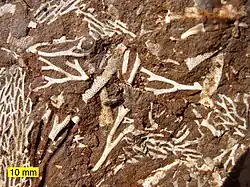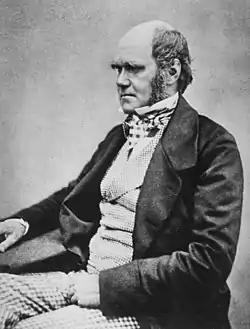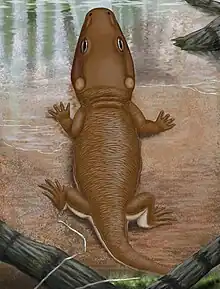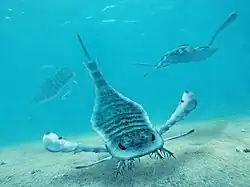The Paleozoic Portal IntroductionThe Paleozoic (IPA: /ˌpæli.əˈzoʊ.ɪk,-i.oʊ-, ˌpeɪ-/ PAL-ee-ə-ZOH-ik, -ee-oh-, PAY-; or Palaeozoic) Era is the first of three geological eras of the Phanerozoic Eon. Beginning 538.8 million years ago (Ma), it succeeds the Neoproterozoic (the last era of the Proterozoic Eon) and ends 251.9 Ma at the start of the Mesozoic Era. The Paleozoic is subdivided into six geologic periods (from oldest to youngest): Some geological timescales divide the Paleozoic informally into early and late sub-eras: the Early Paleozoic consisting of the Cambrian, Ordovician and Silurian; the Late Paleozoic consisting of the Devonian, Carboniferous and Permian. The name Paleozoic was first used by Adam Sedgwick (1785-1873) in 1838 to describe the Cambrian and Ordovician periods. It was redefined by John Phillips (1800–1874) in 1840 to in cover the Cambrian to Permian periods. It is derived from the Greek palaiós (παλαιός, "old") and zōḗ (ζωή, "life") meaning "ancient life". The Paleozoic was a time of dramatic geological, climatic, and evolutionary change. The Cambrian witnessed the most rapid and widespread diversification of life in Earth's history, known as the Cambrian explosion, in which most modern phyla first appeared. Arthropods, molluscs, fish, amphibians, reptiles, and synapsids all evolved during the Paleozoic. Life began in the ocean but eventually transitioned onto land, and by the late Paleozoic, great forests of primitive plants covered the continents, many of which formed the coal beds of Europe and eastern North America. Towards the end of the era, large, sophisticated synapsids and diapsids were dominant and the first modern plants (conifers) appeared. (Full article...) Selected article on the Paleozoic world and its legacies Ordovician bryozoans. Mineralized skeletons of bryozoans first appear in rocks from Early Ordovician period, making it the last major phylum to appear in the fossil record. This has led researchers to suspect that bryozoans had arisen earlier but were initially unmineralized, and may have differed significantly from fossilized and modern forms. Early fossils are mainly of erect forms, but encrusting forms gradually became dominant. It is uncertain whether the phylum is monophyletic. Bryozoans' evolutionary relationships to other phyla are also unclear, partly because scientists' view of the family tree of animals is mainly influenced by better-known phyla. Both morphological and molecular phylogeny analyses disagree over bryozoans' relationships with entoprocts, about whether bryozoans should be grouped with brachiopods and phoronids in Lophophorata, and whether bryozoans should be considered protostomes or deuterostomes. (see more...) Selected article on the Paleozoic in human science, culture and economics Photograph of Charles Darwin. His five-year voyage on HMS Beagle established him as an eminent geologist whose observations and theories supported Charles Lyell's uniformitarian ideas. Darwin later published his theory of evolution with compelling evidence in his 1859 book On the Origin of Species, overcoming scientific rejection of earlier concepts of transmutation of species. By the 1870s the scientific community and much of the general public had accepted evolution as a fact. However, many favoured competing explanations and it was not until the emergence of the modern evolutionary synthesis from the 1930s to the 1950s that a broad consensus developed in which natural selection was the basic mechanism of evolution. In modified form, Darwin's scientific discovery is the unifying theory of the life sciences, explaining the diversity of life. In recognition of Darwin's pre-eminence as a scientist, he was honoured with a major ceremonial funeral and buried in Westminster Abbey, close to John Herschel and Isaac Newton. Darwin has been described as one of the most influential figures in human history. (see more...) Selected image
Did you know? Restoration Tambachia.
Need help?Do you have a question about Paleozoic that you can't find the answer to? Consider asking it at the Wikipedia reference desk. TopicsGeochronology - Cambrian (Early - Middle - Late) - Ordovician (Early - Middle - Late) - Silurian (Early - Wenlock - Ludlow - Late) - Devonian (Early - Middle - Late) - Carboniferous (Mississippian - Pennsylvanian)- Permian (Early - Middle - Late) Paleozoic landmasses - Pannotia - Baltica - Laurentia - Siberia - Avalonia -Gondwanaland - Laurentia - Euramerica - Gondwana - South China- Pangaea Major Paleozoic events - Cambrian Explosion - Cambrian substrate revolution - End-Botomian mass extinction - Cambrian–Ordovician extinction event Cambrian biota appearances - Brachiopods - Burgess shale fauna - Cephalopods - Chitons - Crustaceans - Echinoderms - Foraminiferans - Graptolites - Radiolarians -Trilobites - Vertebrates Ordovician biota appearances - Conodonts - Echinoids Silurian biota appearances - Fungi - Galeaspids - Heterostracans - Land plants - Pituriaspids -Ray-finned fishes - Scorpions - Trigonotarbids Devonian biota appearances - Crabs - Ferns - Harvestmen - Lichens - Lycophytes - Mites -Springtails - Stoneworts - Trimerophytes Carboniferous biota appearances - Amphibians - Hagfishes - Insects - Ratfishes - Reptiles -Synapsids Permian biota appearances - Beetles - Pelycosaurs - Temnospondyls - Therapsids Fossil sites - Bear Gulch Limestone - Beecher's Trilobite Bed - Gilboa Forest - Grenfell fossil site - Hamilton Quarry - Mazon Creek fossil beds - Mississippi Petrified Forest - Walcott Quarry - Walcott–Rust quarry - Yea Flora Fossil Site Stratigraphic units - Burgess Shale - Chazy Formation - Columbus Limestone - Fezouata formation - Francis Creek Shale - Gogo Formation - Holston Formation - Hunsrück Slate - Jeffersonville Limestone - Karoo Supergroup - Keyser Formation - Kope Formation - Llewellyn Formation - Mahantango Formation - Maotianshan Shales - Marcellus Formation - Millstone Grit - New Albany Shale - Old Port Formation - Old Red Sandstone - Potsdam Sandstone - Red Beds of Texas and Oklahoma - Rhynie chert - Shawangunk Formation - St. Peter Sandstone - Tuscarora Formation History - History of paleontology - Timeline of paleontology - The Great Devonian Controversy Researchers - Charles Emerson Beecher - Ermine Cowles Case - Edward Drinker Cope - Henry De la Beche - Stephen Jay Gould - Increase A. Lapham - Charles Lapworth - Simon Conway Morris - Roderick Murchison - Alfred Sherwood Romer - Neil Shubin - Charles Doolittle Walcott Culture - Animal Armageddon - The Day The Earth Nearly Died - List of creatures in the Walking with... series - Lost Worlds, Vanished Lives - Miracle Planet - Prehistoric Park - Sea Monsters - Treatise on Invertebrate Paleontology - Vertebrate Paleontology - Walking with Monsters - Wonderful Life Quality ContentFeatured Paleozoic articles - Bone Sharps, Cowboys, and Thunder Lizards - Bone Wars - Edward Drinker Cope - Geology of the Capitol Reef area - Geology of the Death Valley area -Geology of the Grand Canyon area - Geology of the Zion and Kolob canyons area Good Paleozoic articles - Chitinozoan - Coal ball - Dimetrodon - History of paleontology - Evolutionary history of life - Ornatifilum - Opabinia - Paleontology- Schinderhannes - Small shelly fauna - Temnospondyli - Tiktaalik - Waptia Subcategories Paleozoic Paleozoic by continent Paleozoic geochronology Paleozoic geology Paleozoic life Paleozoic paleogeography Paleozoic paleontological sites Paleozoic portals Paleozoic stubs Things you can do
Current Paleozoic FACs - none currently Related contentAssociated WikimediaThe following Wikimedia Foundation sister projects provide more on this subject:
Discover Wikipedia using portals
|

